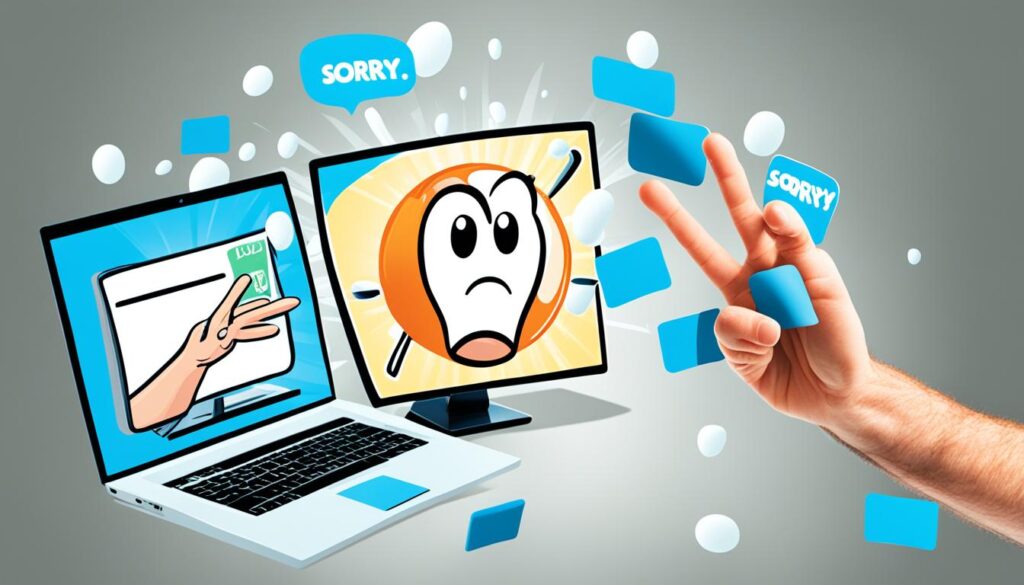Apologizing to a customer for bad service is crucial for maintaining positive relationships and ensuring customer satisfaction. When mistakes happen, acknowledging the error and taking responsibility is essential. One powerful way to do this is by sending an apology letter. In this article, we will guide you through the process of apologizing effectively and provide a sample apology letter to help you restore client relationships.
Key Takeaways:
- Apologizing to customers for bad service is important for maintaining positive relationships.
- Sending an apology letter is a powerful way to express regret and take responsibility for mistakes.
- Expressing genuine regret and acknowledging the customer’s emotions is crucial.
- A well-crafted apology letter should admit the mistake, explain what happened, and offer a plan to make things right.
- Dos of writing an apology letter include expressing sincere regret, understanding the customer’s goals, and offering appropriate follow-up.
The Importance of Expressing Regret and Taking Responsibility
When apologizing to a customer, it is crucial to express genuine regret for the inconvenience caused. Acknowledging the customer’s emotions and articulating the responsibility your company takes for the mistake helps build empathy and understanding. By demonstrating that you understand the customer’s goals and how the error affected them, you can show your commitment to rectifying the situation.
Taking responsibility for the mistake is essential in rebuilding trust with the customer. It shows humility and a dedication to resolving the issue at hand. Expressing regret and acknowledging the customer’s emotions lets them know that their concerns are valid and important to your company.
Understanding the customer’s goals and how the error impacted their progress is crucial for providing a meaningful apology. By demonstrating that you comprehend their objectives, you can show that your primary focus is to address their specific needs and offer a resolution that aligns with their goals.

Expressing regret and taking responsibility are vital steps in the process of restoring customer satisfaction and loyalty. The customer needs to feel heard, understood, and valued. Through genuine apologies, you can begin the journey of rebuilding trust and working towards a resolution that aligns with the customer’s goals and expectations.
Crafting an Effective Apology Letter: Key Components
When it comes to apologizing to a customer, a well-crafted apology letter can make all the difference. It is important to include specific elements that demonstrate sincerity and a genuine desire to make things right. By following a structured approach and addressing key components, you can effectively admit the mistake, explain what happened, and repair the wrongdoing.
Admit the Mistake
The first step in crafting an effective apology letter is to admit the mistake outright. Taking full responsibility for the error shows honesty and accountability. By acknowledging the mistake, you validate the customer’s concerns and establish a foundation for rebuilding trust.
Explain What Happened
Once you’ve admitted the mistake, it is crucial to provide a clear explanation of what happened. Transparency is key in helping the customer understand the circumstances surrounding the error. By offering a detailed account of the events, you demonstrate a commitment to open communication and show that you have thoroughly assessed the situation.
Repair the Wrongdoing
In addition to admitting the mistake and explaining what happened, it is important to offer a plan to repair the wrongdoing. This could involve outlining steps to rectify the issue, providing a timeline for resolution, or offering a solution that addresses the customer’s specific concerns. By demonstrating your commitment to making things right, you show the customer that their satisfaction is your top priority.
Crafting an effective apology letter requires careful consideration of these key components. By admitting the mistake, explaining what happened, and providing a plan to repair the wrongdoing, you can convey your sincerity and dedication to resolving the issue at hand.

| Admit the Mistake | Explain What Happened | Repair the Wrongdoing |
|---|---|---|
| Take full responsibility for the error | Offer a clear explanation of the events | Outline steps to rectify the issue |
| Validate the customer’s concerns | Show a commitment to open communication | Provide a timeline for resolution |
| Establish a foundation for rebuilding trust | Ensure the customer understands the circumstances | Offer a solution that addresses specific concerns |
Dos and Don’ts of Writing an Apology Letter
When writing an apology letter to a customer, it is important to follow certain guidelines to ensure the effectiveness of your message. By adhering to the dos and avoiding the don’ts, you can create a sincere and impactful apology letter that resonates with the recipient.
The Dos of Writing an Apology Letter:
- Express sincere regret: Begin your letter by genuinely expressing regret for the mistake or issue.
- Admit the mistake: Take responsibility for the error and acknowledge the impact it had on the customer.
- Explain the situation: Provide a clear and honest explanation of what happened without making excuses.
- Understand the customer’s goals: Show empathy and demonstrate that you understand how the mistake affected the customer’s expectations.
- Repair the wrongdoing: Offer a concrete plan to rectify the situation and make amends for the mistake.
- Ask for feedback: Encourage the customer to share their thoughts and suggestions for improvement.
- Offer appropriate follow-up: Ensure the customer knows that their concerns are being taken seriously, and outline any steps you will take to prevent similar issues in the future.
The Don’ts of Writing an Apology Letter:
- Be vague: Avoid using ambiguous language or generic statements that do not address the specific issue.
- Make excuses or blame the customer: Take full ownership of the mistake without deflecting blame or making the customer feel responsible.
- Make the customer wait for resolution: Respond promptly and prioritize resolving the issue to prevent further frustration or dissatisfaction.
By following these dos and avoiding the don’ts, you can create an apology letter that demonstrates your genuine desire to make things right and rebuild the customer’s trust. Remember, a well-crafted apology can go a long way in maintaining positive customer relationships and fostering loyalty.

Common Mistakes Businesses Make in Apologizing
Apologizing to customers for bad service is crucial for maintaining strong relationships and customer satisfaction. However, businesses often make common mistakes in their apology attempts, which can further damage the relationship and leave customers feeling unsatisfied. Avoid these mistakes to ensure your apologies are genuine and well-received.
- Downplaying the customer’s feelings: Never underestimate the impact of a bad experience on your customers. Dismissing their emotions or minimizing the situation can make them feel unheard and unvalued.
- Failing to take ownership of the mistake: It’s important to accept responsibility for the error and show customers that you understand your role in the issue. Avoid placing blame elsewhere or making excuses.
- Making excuses: Providing excuses rather than taking accountability can make your apologies appear insincere. Instead, focus on acknowledging the mistake and expressing genuine regret.
- Keeping the apology vague: A vague apology lacks clarity and may not address the specific issue at hand. Be transparent and provide detailed explanations to demonstrate your understanding of the situation.
- Apologizing excessively: While it’s essential to apologize sincerely, excessive apologies can come across as insincere or repetitive. Find a balance and ensure your apologies are genuine and to the point.
- Offering insincere apologies: Empty or insincere apologies can do more harm than good. Take the time to understand the customer’s perspective and express genuine remorse for the inconvenience caused.
- Trying to buy off the customer’s feelings with gifts: While offering compensation or gifts can be a part of resolving a customer issue, using them as a way to appease customers without addressing the underlying problem can seem insincere. Focus on resolving the issue genuinely.
By avoiding these common mistakes, you can ensure that your apologies are thoughtful, sincere, and effective in rebuilding trust and maintaining positive customer relationships.

Templates for Apology Letters in Different Situations
Apologizing to customers can be a daunting task, especially when you’re not sure where to begin. That’s where apology letter templates come in handy. These templates provide a structured format to address various situations that may require an apology. Whether you’re dealing with an unhappy customer, a defective product, poor customer service, miscommunication, or any other mistake, having a template can simplify the letter-writing process.
By using apology letter templates, you can save time and ensure that your apology is comprehensive and sincere. These templates serve as a framework for expressing your regret, admitting the mistake, and outlining your plan to rectify the situation. They can help you convey empathy, understanding, and a genuine desire to make things right.
While using templates is a helpful starting point, it’s essential to personalize them to align with your company’s brand voice and the specific circumstances of the apology. Tailoring the templates allows you to put a personal touch on the letter, making it more authentic and meaningful to the recipient.
Remember, each situation may require a different approach, and choosing the right template for the occasion can make a significant impact. Apology letter samples are readily available online, and you can adapt them to fit your unique requirements. With these templates at your disposal, you can effectively apologize to customers in various situations, restore their trust, and work towards resolving any issues they may have experienced.
FAQ
Why is it important to apologize to a customer for bad service?
Apologizing to a customer is essential for maintaining positive relationships and customer satisfaction. It shows that you acknowledge the mistake and are committed to rectifying the situation.
How can I express regret and take responsibility for bad service?
It is crucial to genuinely apologize to the customer and acknowledge their emotions. Take responsibility for the mistake and show understanding of the customer’s goals and how the error affected them.
What should be included in an apology letter for bad service?
An effective apology letter should admit the mistake, explain what happened, and offer a plan to repair the wrongdoing and make things right for the customer.
What are the dos when writing an apology letter?
The dos include expressing sincere regret, admitting the mistake, explaining the situation, understanding the customer’s goals, repairing the wrongdoing, asking for feedback, and offering appropriate follow-up.
What are the don’ts when writing an apology letter?
The don’ts include being vague, making excuses or blaming the customer, and making the customer wait for resolution.
What are common mistakes businesses make when apologizing to customers?
Common mistakes include downplaying the customer’s feelings, failing to take ownership of the mistake, making excuses, keeping the apology vague, apologizing excessively, offering insincere apologies, and trying to buy off the customer’s feelings with gifts.
Are there templates available for apology letters in different situations?
Yes, templates can be used as a framework for addressing specific issues such as inconvenience, unhappy customers, defective products, poor customer service, miscommunication, and mistakes. Personalize these templates to fit your company’s brand voice.
